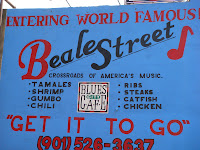However, I feel compelled to include this business jaunt and make it a part of my Penelope Road travels because, despite the rain, wind, awful hotel, runny scrambled eggs, and heavy laptop, my first 12 hours here remind me that I have something to learn about kinks, snafus, and New Yorkers who think they're funny (but they're not--at least not at midnight after I've been on a plane all day).
So it's not a road I'm on, but a street, an avenue, a hotel lobby, a chilly marble convention center bench. Vision is limited here, especially when the weather demands I stay hidden under an umbrella. Furthermore, I need to dodge in and out of herds of hurried people scuttling here and there (if you think herds don't scuttle you haven't seen a crowd emerge from a NYC subway at 7:30 in the morning). This doesn't leave me much of an opportunity to stop (if I do, I shall surely be run over by boot or wheel) and look, gaze (stare) and people watch. Forget walking to meditate or ponder or relax. If I don't have a purpose, a concrete (ha) destination to which I speed walk without making eye contact with anyone, I shall surely be run over by high-heeled shoe or wheel.
It really doesn't help that in the only chunk of free time I have while I am in this city, it is raining. Hard. And it's windy. And I am really cursing myself for bringing a heavy laptop.
So a few questions:
- Why is it that I can get a hair dryer and in-room coffee in a no name motel in Gallup New Mexico ($59 per night) and not have the same small conveniences in a major hotel in midtown Manhattan ($229 per night)?
- What major hotel DOESN'T have in-room wifi? The one I'm paying handsomely for in midtown Manhattan.
- Why does it really take soooo long for luggage to make it from the airplane to the carousel? It's not as if the baggage handlers are bringing them one by one, on foot. I also want to know why "they" sound the red light alert and start the carousel running and bags don't appear for another 20 minutes? I'm really not in the mood to be teased like that after a 6 hour flight.
- Why do I always forget that many, many people smoke? It always takes leaving California for me to be reminded of this fact. I forget I am in a city that believes a non-smoking hotel room (for $229 per night) is smoke free while next door to people who seem to be chain smoking all night long. Give me a hair dryer, in-room coffee and something to get the smell of stale cigarette smell out of my clothes.
Travel this fall has been fraught with grim reminders that all is not bouncing yellow daisies on the prairie. I'd like to know what the equivalent is here in New York City though. I'm sure there is something I can stop and look at--just need to walk around a little more to find it.
I did find an excellent cup of coffee, however, at a no-name walk-in joint.
Onward...




































